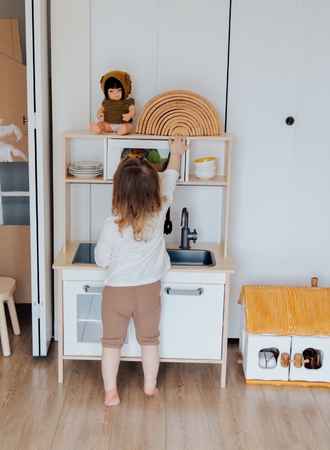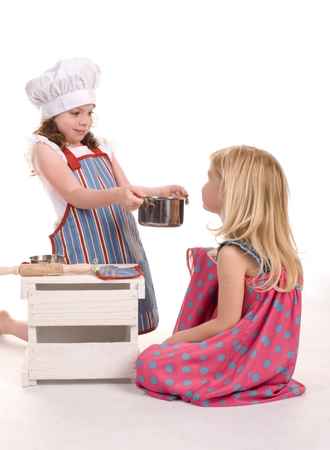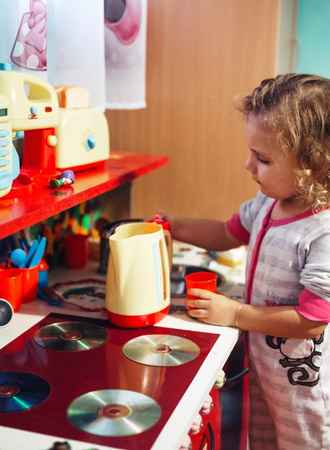Contemplating the introduction of kitchen play to your young one and curious about its underlying benefits? You’re not alone. Many parents and educators have observed the sheer joy and engagement that kitchen play brings but might not fully grasp the depth of developmental advantages it offers.
Fortunately, kitchen play, whether through a play kitchen set, pretend food, or even real cooking experiences, is a rich avenue for holistic growth in the early years.
Drawing from my expertise in child development and play-based learning, I’ve whipped up a comprehensive guide that explores the multifaceted benefits of kitchen play during the early years. This guide will touch upon cognitive, emotional, social, and physical benefits, among others.
Let’s simmer down and unpack the delightful concoction of skills and lessons that kitchen play serves up for young, budding chefs and homemakers.
Key Takeaways on the So Many Great Benefits of Play Kitchen
- Play kitchens are a great way to encourage children’s development, both cognitively, socially and linguistically.
- When choosing a play kitchen for your family, it is important to consider safety first.
- Many children love imaginative scenarios and kitchen role play offers enormous play potential, making them a popular gift with many parents.
Benefits of Play Kitchens
There are so many benefits to playing with toy kitchens. A child’s kitchen set is a fun way to engage kids in imaginative play and help develop their problem-solving ability, gross motor skills, cognitive, social and language skills. Children develop skills through play, so this particular type of fun activity is good for their development.
| Benefit | Description |
|---|---|
| Cognitive Development | Children practice problem-solving, sequencing (e.g., following a “recipe”), and understanding cause and effect (e.g., “cooking” food). |
| Creativity & Imagination | Pretend play in a toy kitchen allows children to create scenarios, recipes, and role-play various situations. |
| Language & Vocabulary | Children learn names of foods, kitchen utensils, and actions associated with cooking, expanding their vocabulary. |
| Math Skills | Pretend cooking introduces concepts like counting, measurement, and portioning. |
| Fine Motor Skills | Activities like “cutting” vegetables, “stirring” pots, and handling small utensils enhance hand-eye coordination and dexterity. |
| Social Skills | Sharing the kitchen space, taking turns, and playing different roles (e.g., chef, waiter) fosters teamwork and communication. |
| Understanding Nutrition | Discussing different foods and their nutritional values can introduce basic health and nutrition concepts. |
| Emotional Development | Kitchen play can be therapeutic. Children can express emotions, and it can be a platform for understanding care (e.g., “cooking” for someone). |
| Independence & Confidence | Successfully “preparing a meal” can boost a child’s self-esteem and promote a sense of independence. |
| Cultural Awareness | Introducing diverse pretend foods and discussing various cuisines can broaden a child’s cultural understanding. |
| Safety Awareness | Discussions about pretend ovens, stovetops, and “hot” pots can be a starting point for teaching real-life kitchen safety. |
Cognitive development
Playing with kitchen sets helps children learn basic math concepts such as counting, measuring ingredients, understanding fractions, following directions and more. It also encourages problem solving skills by having a young toddler figure out how to put together the pieces or create recipes from what they have on hand.
Additionally, it can help build their fine motor skills as they manipulate utensils and food items in the kitchen set and solve when problems arise.

Social development
Role playing with friends or family members is a great way for children to practice their communication skills while exploring different scenarios in a safe environment. They can take turns being the chef or customer while working on manners such as saying please and thank you when ordering food or sharing meals at the table.
Language development
Playing with kitchen sets offers plenty of opportunities for language development. As kids play with other children, they are exposed to new words related to cooking, such as “stir”, “mix” and “pour”, which can increase their vocabulary significantly if played often enough. Older children may even start making up stories and move on to more complicated vocabulary needed for their plays and own interests.
Older kids can also practice writing and develop positive attitude toward real cooking.

Fine motor skills
Playing with kids kitchen sets and laying a table for a pretend tea party with cuddly toys allow children to develop hand eye coordination and fine motor skills required for the activity.
Children can practice using utensils such as spoons, forks, and knives to develop their grip and hand-eye coordination. Manipulating smaller items like fruits, vegetables, and kitchen tools can help to refine their dexterity and precision. Assembling and disassembling toy kitchen sets can help improve their finger strength and dexterity.
Types of Play Kitchens
When it comes to play kitchens, there are many options available. Wooden play kitchens offer a classic look that can last for years and come in a variety of styles and colors. They often feature realistic details like knobs, drawers, cupboard door with clicking sound, oven mitts, shelves and more.
Wooden play kitchens
Wooden play kitchens are an excellent present and perfect for those looking for something timeless yet durable enough to withstand wear-and-tear over time.
The natural wood finish gives them a classic feel while providing plenty of room for customization if desired – you could paint them any color you want or even add accessories like toy food items or dishes! Additionally, some wooden models include removable parts and play food.
Some sets have optional accessories such as mixers and smoothie makers that allow kids to enjoy pretend play.
Plastic play kitchens
Plastic play kitchens offer an affordable option compared to their wooden counterparts but still provide plenty of imaginative fun for kids!
These models typically come in bright colors such as pink or blue which helps bring out the playful side in children when pretending to cook up delicious meals using all sorts of plastic utensils included in the set (e.g., pots & pans).
Some plastic models may also include additional features such as lights & sounds and pretend food sets which are good for playing complex games.
Electronic play kitchens
Electronic play kitchens take things one step further by introducing interactive elements. These may include touchscreens where kids can select different recipes or voice commands that let them control certain functions from afar.
This type is great if you are looking for something modern yet educational, as these types usually come preloaded with games and activities designed specifically to help develop problem solving skills, hand-eye coordination, and other cognitive abilities while having fun.

Safety Considerations for Play Kitchens
When shopping for a play kitchen, safety should be your top priority.
- Age appropriate toys are essential to ensure the child is not playing with something too advanced or dangerous for their age. For example, if you’re buying a play kitchen set for a toddler, make sure it doesn’t have any small parts that could easily become choking hazards.
- Avoiding choking hazards is also key when selecting a play kitchen set. Look out for removable pieces such as knobs and handles which can come off easily and pose a risk of being swallowed by younger children. Make sure all the pieces are securely attached to the toy before purchasing it.
- Fire safety tips should also be taken into consideration when using any type of stove or oven in the kitchen setup. It’s important to supervise young children while they’re playing with these types of toys so they don’t accidentally start an actual fire.
- Always check that all parts of the play kitchen are made from non-toxic materials such as wood or plastic without any sharp edges or corners that could cause injury during use. By following these simple tips, you can ensure your child has fun while staying safe at all times.

FAQs on Benefits of Play Kitchen on Child’s Development
Is it worth getting a play kitchen?
Yes, a play kitchen is worth getting for families with children. It encourages imaginative and creative play while teaching children about food preparation and cooking. Additionally, it can be an excellent way to introduce the concept of sustainability and zero waste living to kids in a fun and engaging way.
Play kitchen sets are also great for developing motor skills, problem solving abilities, communication skills, and more. As kids grow older, the games they play become more complicated and let them imitate real life.
What is the perfect age to get a play kitchen?
The age at which a child should get a play kitchen depends on the individual child and their level of development. Generally, children between the different ages of 3 and 5 are ready to begin playing with a play kitchen. It is important to consider the child’s physical capabilities, cognitive abilities, and emotional maturity when deciding if they are ready for this type of toy.
During the early years, you can see a young child enjoying toy kitchens with older siblings. You can watch them as they learn the basic cooking skills such as measuring ingredients or stirring batter in an imaginary pot like they would in a real kitchen. They may also be able to role-play different scenarios like hosting tea parties or serving meals to family members.
Ultimately, it is up to parents to decide when their child is ready for a play kitchen based on their own observations and judgement.







